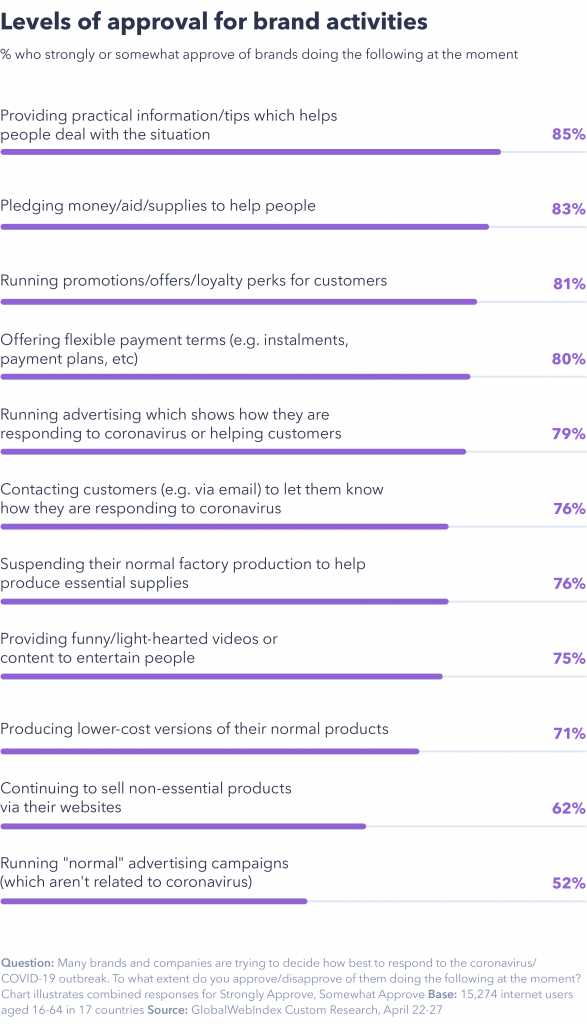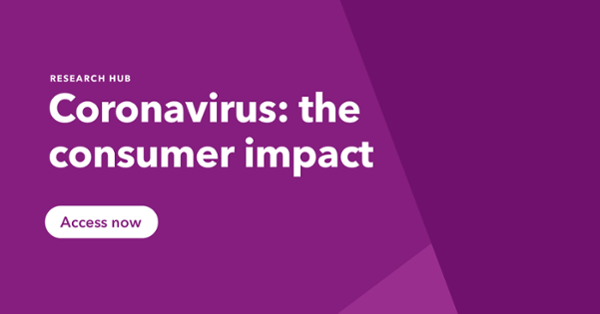Any brand worth its salt has a carefully considered and configured strategy to land and retain loyal customers. But in these unprecedented times, a conventional strategy may fall short of hitting consumers where it counts.
Certain sectors may be in for a bumpy ride, but for the likes of CPG, there are endless opportunities to create and maintain brand loyalty right now – something that’s more important than ever during a crisis.
By the end of March, an estimated one third of the global population was under lockdown.
So what’s the key to not only surviving, but thriving, in a post-corona world? Here’s why it will pay to pinpoint the specific elements of importance for your target audience.
Our latest research reveals key insights into how COVID-19 has disrupted the brand-consumer relationship, and uncovers fact-based guidance on how CPG brands can adapt to the pandemic.
Keep advertising – but do it mindfully.
Key findings:
- 85% either approve of, or are impartial to, carrying on as normal.
- 85% want brands to provide practical information/tips to help them deal with the current situation.
- 83% want to see brands pledging money / aid / supplies to help people.
- 75% want to see brands offering funny / light-hearted content to keep them entertained.
Despite many brands calling a halt to their advertising in response to the crisis, our latest multinational research shows there’s almost no consumer concern about brands advertising at this time. In fact, 85% either approve of, or are impartial to, carrying on as normal. Just 10% somewhat disapprove and 5% strongly disapprove.
The message is clear: stay away from false purpose and ‘woke-washing’, but continue advertising in the way consumers are asking.
Brands must be sensitive to the challenges their target audiences face right now, and the worst thing to do is to ignore them.
Instead, focus on how your brand can support your customers through this. After all, why should they be loyal to your brand if you’re not loyal to them during difficult times?
Ensure a top-notch online shopping experience.
Key findings:
- Around 3 in 10 plan to shop online more for groceries, household essentials and personal care products.
- Over 40% say they will shop online more frequently after the outbreak.
- 71% spend more time on their smartphone since the start of the COVID-19 outbreak.
With in-person shopping being relegated to stores offering essential goods for now, brick-and-mortar retail locations may see reverberations for a long time.
And with nearly half of our respondents across 17 markets saying they’ll shop online more even after the pandemic, there’s a clear need for brands in this space to be at the top of their game. This means not only having an online offering to match your offline one, but investing heavily in the things consumers appreciate – starting with convenience.
Be adaptable and reactive.
Key findings:
- Half strongly approve of brands pledging money, aid or supplies to help people.
- Around a third will be using their savings, reducing their regular financial commitments (e.g. subscriptions), or waiting for products to be on promotion or sale.
It should come as no surprise that shopping habits have changed. And with these changes, brands need to adapt.
Rather than focusing on driving sales, this is a time for increased investment into brand awareness and equity. Consumers are keen to see their favorite brands lend a helping hand to society, and are bound to remember those that did during this crisis when shopping habits start to normalize.
Reach the consumer directly.
With the switch to ecommerce channels accelerating and consumers looking for secure, authentic supply, digital experience and generally more content from brands, the role of direct-to-consumer marketing takes on new salience.
The core benefits of a DTC strategy align perfectly with the many challenges coronavirus brings to the CPG industry. By being direct, you can:
- Meet consumers’ expectations.
- Collect more data.
- Have full control of the purchase journey and supply chain.
- Build and own consumer relationships.
- Take charge of your customer service.
- Cut down on costs.
The biggest prize is, of course, the granular data into your own consumers. A direct relationship harnesses knowledge of their why’s and what’s – something that’s crucial to build reliable brand loyalty.
Keep convenience and promotions in mind for a post-COVID world.
Key finding:
- 81% want brands to run offers/promotions/loyalty perks for customers.
For those planning to increase their online shopping, home delivery is around twice as popular as in-store collection.
Compared to before the outbreak, free delivery (51%) and reliable delivery (51%) have become more important to people.
While for the wider retail industry, outlet closures and changing consumer attitudes are creating a need for enhanced promotional strategies to cut through the noise, CPG brands may be experiencing the opposite end of the spectrum. For them, it’s all about keeping momentum.
With many consumers stockpiling everyday essentials, supply can be sparse. This challenges CPG brands to ensure consumers see their products on the shelves to keep their loyalty switched on.
With the increased demand, it may not be possible for consumers to stick to their tried-and-tested brands. This lack of availability offers opportunities to switch brands, categories and channels, and creates a need to recapture consumers once the pandemic eases.
This is where offers and promotions come in.
Running promotions is a key consideration for consumers during the pandemic (up by 6 points) – suggesting many people are preparing to start purchasing again, and are looking for financial support from brands.
The appeal of promotions transcends age, income and gender but the higher income group is 5 points ahead of the lower income one. Clearly, the appetite for value-for-money in the post-covid landscape will be widespread.
For CPG brands struggling to know where to look once we firmly reach the ‘new normal’, bringing these convenient solutions forth and giving them more attention across your marketing is a good place to start.
Stay on top of the latest shifts.
Things change fast during a pandemic, and it’s crucial to stay on top of dynamic consumer habits and expectations. What’s tasteful one week may be tonedeaf the next.
This makes insight into your target audience more important than ever before. Findings like the ones above give a solid foundation for CPG brands that are having to do things differently, maybe for the first time.

The CPG brands doing it right
Making a difference while staying on brand: BrewDog
In a stroke of agile marketing (and humanitarian) genius, UK beer distillery BrewDog has started using its facilities to manufacture hand sanitizer.
Its website proclaims: “These are unprecedented times we are living in and we are determined to do all we can to help those in need.
“We started making hand sanitiser at our distillery in Aberdeen in response to the national shortage and since then, production has been running round the clock.”
Hand sanitiser is selling out everywhere. So we have started using our distillery to make Punk Sanitiser. We want to do all we can to help everyone get through this difficult time. pic.twitter.com/mDCQLCyPX6
— James Watt (@BrewDogJames) March 18, 2020
The brand, known for its irreverent marketing, took a more serious than usual approach and began collaborating with the NHS and local charities, working around the clock to provide hand sanitizer to those in need.
So far, 5,000 bottles have been donated to the NHS and a further 100,000 have gone to local charities. It’s a move that’s bound to remain in the mind of customers once they’re back in the pub.
Adapting to changed circumstances: Trojan Condoms
When is one of the worst times to be selling condoms? During a lockdown where your target audience is urged to keep away from each other.
But that didn’t stop Trojan Condoms from seeing opportunities where many would only see obstacles.
Adapting to a situation where the likes of New York City’s Health Department implored people not to partake in casual sex until the COVID-19 pandemic has ended, the brand worked with its agency, 72andSunny New York, to create an on-brand, helpful and slightly cheeky campaign.
Bruce Weiss, VP of Marketing for Trojan Brand Condoms, says, “Trojan Brand Condoms stands for trust and protection, so we worked with our creative agencies and partners to quickly get out messaging that encourages safety and pleasure at home, but in a way that’s relevant to them.”
Encouraging lonely singles to ‘sext us instead’, the campaign is simple but effective: slide into Trojan’s DMs with an eggplant emoji for a chance to be sent free vibrators and lube.
By knowing its consumers’ wants, needs and habits, Trojan Condoms is able to tweak its strategy to not only keep customers switched on to the brand itself, but to the guidelines set during the pandemic too. It’s a masterclass in adaptive marketing.
Being human with a side of (appropriate) fun: IKEA
Facing closures of its stores, global flatpack-furniture giant IKEA discovered a way to engage with its audience while remaining true to its brand identity.
It took to Twitter to release the recipe for its famous meatballs, cleverly presented as a quintessential manual for IKEA furniture assembly.
Lauren Lourido, Country Food Manager of IKEA United Kingdom and Ireland, says, “We know that some people might be missing our meatballs, which is why we’ve released an at-home alternative which, using easily accessible ingredients, will help those looking for some inspiration in the kitchen.
“Staying at home can be hard, but we want to help make everyone’s lives that little bit easier and more enjoyable.”
Keenly aware of the affection loyal IKEA customers have for its meatballs, the brand has kept front-of-mind despite a lack of retail, and shows empathy for people in difficult times without being insincere.
What the future holds
You’ve heard it from the consumers themselves – driving loyalty is all about zeroing in on their fast-changing attitudes and experiences of these extraordinary times.
The COVID-19 pandemic has created a dynamic, fast-paced environment full of unknowns, and it’s understandable for CPG brands to worry whether their customers will still be switched on to their messages and products.
As the virus slowly subsides, so too will these fears – if you’ve stayed proactive in engaging with your target audience, consistently and authentically. After all, brand loyalty has to be earned.

